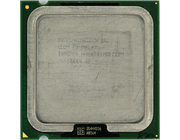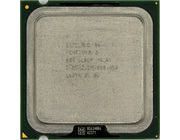Smithfield is Intel's first attempt in creating a dual-core processor. Because AMD already designed the Athlon 64 to incorporate a second core (and thus was ahead on Intel) Intel had to rush to finish the Pentium D 'Smithfield'.
| In short the Pentium D is nothing more than two Pentium 4 'Prescott' dies merged together into one single 'die'. On the right you see a 'die-shot' of the Smithfield. Compare it with the Prescott and see that it is practically equal, apart from color differences. Since Smithfield is nothing more than a dual Pentium 4, it performs just equal to a Pentium 4 if one core is utilized. Whenever the second core can be used it starts to perform a lot better, even despite the fact that two cores have to share one FSB (front-side-bus). |  |
Smithfield teased the thermal limits of the socket 775 motherboards. Especially the Pentium Extreme Edition 840 (Smithfield running at 3.2GHz) put a really high load on voltage regulators and needed adequate cooling. Back in the day Tom's Hardware ran a stress-test (24/7 running of the systems) and many socket 775 motherboards burned out. Nevertheless Intel managed to control the power consumption quite well, considering the Smithfield is actually a double Prescott!








